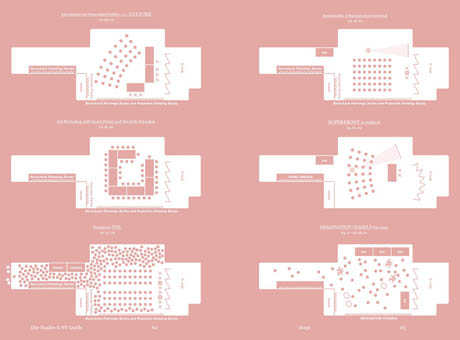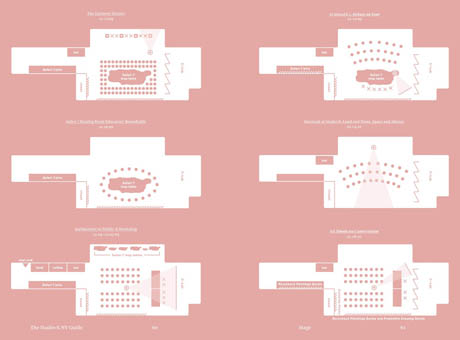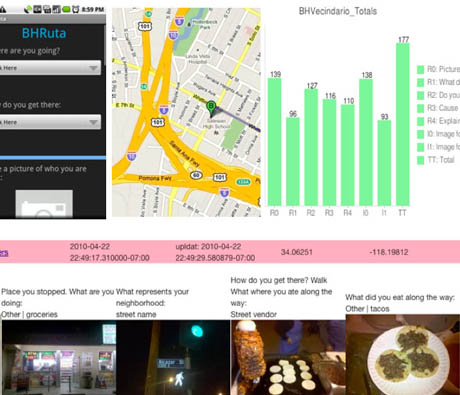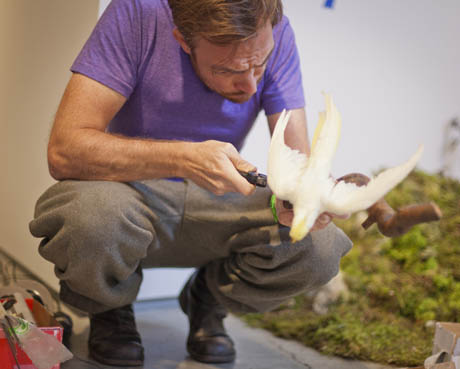Those of you who follow me on Twitter may have already caught this snippet of news, but I’m delighted to announce that Geoff Manaugh (of BLDGBLOG) and I have recently been appointed as co-directors of Studio-X NYC, which is the Lower Manhattan outpost of a global network launched by Columbia University’s Graduate School of Architecture, Planning, and Preservation to explore the future of cities.

IMAGE: Foodprint NYC was generously hosted by Studio-X NYC, back in February 2010. Photo by Rachel Hillery, Columbia GSAPP.
As you can perhaps imagine, this is a pretty exciting opportunity. Studio-X NYC, like its partner Studio-X sites in Rio de Janeiro, Beijing, Moscow, and Mumbai, is intended to be a Swiss Army knife sort of space, reconfiguring to host design workshops, research initiatives, and editorial meetings as comfortably as public exhibitions and events. Each Studio-X location is also imagined as an octopus-like central nervous system, extending its tentacles out into the city and beyond, through everything from tours to blog posts.

IMAGE: Studio-X NYC reformatted, from The Studio-X Guide to Liberating New Forms of Conversation, edited by Gavin Browning.

IMAGE: Studio-X NYC reformatted, from The Studio-X Guide to Liberating New Forms of Conversation, edited by Gavin Browning.
The cumulative goal of each tweet, event, and smell mapping expedition is to generate new perspectives, new insights, and new ideas into the future of the city — to bring together people of diverse disciplines and backgrounds, to experiment with different formats for conversation and engagement, and to develop cautionary, hopeful, and, above all, thought-provoking future scenarios.
Geoff and I are already planning a whole array of events, exhibitions, lectures, tours, podcasts, videos, booklets, maps, night schools, film festivals, design workshops, sound walks, municipal water tastings, dinners, drinks, interview marathons, concerts, interventions, parties, emergency drills, and collaborations, including several with the GSAPP’s own stellar faculty — many of which, I hope, might be of interest to Edible Geography readers.

IMAGE: Studio-X NYC reformatted, from The Studio-X Guide to Liberating New Forms of Conversation, edited by Gavin Browning.
Of course, I will also continue to post here (with more frequency, once this transcontinental move is over), co-direct Foodprint Project events and projects with Sarah Rich (mark your calendars for Foodprint LA on November 5), and co-curate my forthcoming exhibition on the refrigerated spaces of North America with the Center for Land Use Interpretation (of which, more shortly — we just received a generous grant from the Graham Foundation to support our work!).
As we get up and running, you can keep up-to-date with Studio-X NYC’s goings-on via Twitter and email. For now, though, I’d like to invite those of you in New York to our first week of events!

IMAGE: Community data gathered as part of Building a Healthy Boyle Heights initiative (participatory sensing project conceived by Deborah Estrin).
LI@SX (I): Deborah Estrin
Thursday, September 1
12:30 – 1:15pm, Studio-X NYC [map]
This Thursday, we’re hosting the first in our live interview series (Live Interviews at Studio-X, or LI@SX), in which we borrow interesting people for an informal conversation in front of whoever can come, and record, transcribe, and (technology permitting) livestream it for those who can’t. Our first volunteer (victim?) is Deborah Estrin, Professor of Computer Science at UCLA, and co-director of a new non-profit, openmhealth.org.
In 2003, Estrin was named one of Popular Science magazine’s “Brilliant 10” for her work on embedded sensor networks. Meanwhile, Foodprint Project fans may recognise her name as one of the main forces behind our exciting new project: creating a crowd-sourced map of Los Angeles’ food consumption patterns.
At 12:30pm on Thursday, we’ll be grabbing a sandwich together and talking about her new work on participatory sensing, citizen science, and community data gathering, in the context of the city. If you’re around, we’d love for you to bring a brown-bag lunch and join us.

IMAGE: Liam Young installing his Specimens of Unnatural History at the Nevada Museum of Art. Photo by Jamie Kingman.
Landscape Futures Night School with guest Liam Young
Thursday, September 1
6:00 – 8:00pm, Studio-X NYC [map]
As if our lunchtime interview with Deborah Estrin was not enough intellectual stimulation for the day, we’re also hosting the first in our “Night School” series on Thursday evening. Liam Young, co-founder of futures think tank Tomorrows Thoughts Today and leader of the Unknown Fields Division nomadic design studio (newly returned from a summer expedition to Chernobyl and Baikonur), will be joining us to introduce some of his Specimens of Unnatural History, recently installed as part of curator Geoff Manaugh’s Landscape Futures exhibition at the Nevada Museum of Art.
Following on from that, Liam and Geoff will be leading an interactive conversation, whiteboard brainstorm, and armchair journey around the world, exploring fieldwork as a form of research toward site-specific responses. Expect to discuss everything from Australian kangaroo culls and invasive species bio-control to conflict metals and boat rentals in the Congo, as a springboard to generate alternative scenarios and explore their spatial implications.

IMAGE: Cover of Geologic City, by Smudge Studio.
Geologic City Book Launch and Exhibition with Smudge Studio, Kevin Allen, and Meg Studer
Thursday, September 8 — Thursday, September 22
Launch: Thursday, September 8, from 6:00 — 8:00pm, Studio-X NYC [map]
Join us at this launch party for artists’ Jamie Kruse and Elizabeth Ellsworth of Smudge Studio’s new publication, Geologic City: A Field Guide to the GeoArchitecture of New York. In addition to the opportunity to purchase this invaluable pamphlet, which will take you to twenty urban sites and equip you with the tools to detect their geologic history, Kruse and Ellsworth will also guide you through an interactive installation based on their guide.
Alongside their work will be that of two of their collaborators, Kevin T. Allen and Meg Studer, who will offer you the chance to listen to New York’s geology as experienced by the Brooklyn Bridge, and to trace the temporal and geographic trajectory of one of the city’s most ubiquitous imported geologies: road salt.

IMAGE: Salt map, by Meg Studer.
***All events are free, open to the public, and take place at 180 Varick St, Suite 1610, New York. Unfortunately, at least for the time being, we require an RSVP to studioxnyc AT gmail DOT com.***
If you can come to any or all of the above, we’d love to see you. As I mentioned before, if you’d like to stay up-to-date with Studio-X NYC, join our email list and follow us on Twitter. If not, pardon the interruption, and please stick around for a return to regularly scheduled programming on Edible Geography…